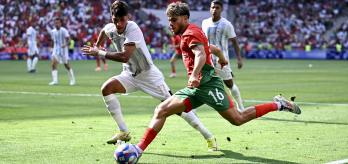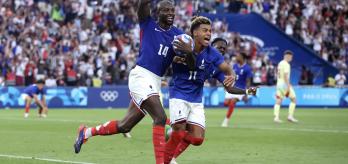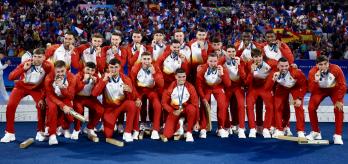Pascal Zuberbühler observed both games and identified some distinguishable principles in Team USA’s in-possession game.
“USA are very comfortable in their passing style and all 11 players are involved in how they build their play. The outfield players get very good support from their goalkeeper Patrick Schulte (1), and the variety and accuracy in his distribution means he can play to outfield players who become free [in situations where] he is pressed.
“They make the pitch really big when they have the ball, both from goal kicks and after they win the ball back. They establish possession and build with both patience and tempo, being direct and playing forward when the time and scenarios are right. If it’s not on to play forward, they recycle the ball and start their build up again. Even when they made substitutions, it did not disturb the rhythm of how they played. Every player knew their roles and the movements needed during the build-up phases,” he explained.
Enlarging the pitch during build-up & controlled directness
When the USA begin their build-up phase, the players immediately expand their team shape by moving into high and wide positions to make their playing space as big as possible, and therefore making it difficult for their opponent to get effective direct pressure on their possession. The speed at which USA move the ball also helps this, in addition to the constant movements by other outfield players to create passing lanes and options for the player on the ball.
A key trigger in deciding when to play the ball forward is whether the whole team can move forwards with it. They do not want to leave team-mates isolated with the ball, so instead will choose to recycle possession until they can break lines and gain territory in the opposition’s half with players to support and bring momentum to the attack.
In the clips below, Zuberbühler highlights some the key features of USA’s build-up play.
“We can see how involved the goalkeeper is there is in the build-up and how comfortable all players are on the ball. Notice how the players expand their team width and have open body shapes to increase their passing options once they receive the ball. When the left centre-back Walker Zimmerman (3) receives the ball from his goalkeeper, his body shape is open, and as soon as he plays back to Schulte, New Zealand increase the intensity and proximity of their press.
“This is crucial because it’s a 3v3 press on USA’s deepest players and also the goalkeeper is under pressure. But what I like here is the movement of their left-back John Tolkin (5). He drops when he sees the press and opens a passing lane for his goalkeeper to play over the press and to break the line. Immediately he plays forward and switches the play to the far-right side, again using the width of the pitch, while USA also get four additional players forward to support the attack,” he explains.
In clip 2, similar principles are followed when the USA recycle possession from a cleared attacking corner. They do not play forward in risky situations or when they feel the receiver may become isolated, using the width in their build-up and switches of play when they draw the opposition in on one side. They have the technical ability to triangulate quick passes with good movement ahead of the ball, that helps them to escape pressure.
Using New Zealand’s aggression to their advantage
Recognising that New Zealand wanted to press high, the USA were deliberate in their bid to use this strategy to their advantage. As well as using the full width of the pitch in build-up – and in light of New Zealand’s high press – the USA were also keen to exploit field depth. When attempting to build play, USA defenders often dropped deeper, using their goalkeeper as a spare player and simultaneously drawing in the front line of New Zealand’s press further away from their team structure. The disjointed Kiwi shape left gaps between the lines for USA to exploit once they broke the press.
According to Zuberbühler, “Because USA’s defender’s and goalkeeper were comfortable on the ball, they were happy to draw the high press closer to their own defensive third. Their left-back Tolkin was very effective at becoming the spare player and moving to be the out-ball option. Once they broke the press, their centre-midfielders were very effective at switching play. This meant that USA distorted New Zealand’s defensive shape and were able to play through it.”
During this match, USA completed 11 key distributions under pressure with Tolkin and left winger Paxten Aaronson (11) most effective, with three each. In addition, USA completed a total of 56 line breaks under pressure, with Tolkin again being very influential, completing ten of these. USA also had 118 receptions between their opponent’s midfield and defensive lines, with midfielder Jack McGlynn (16), introduced in the 36th minute as a substitute, ranked number one in the game with 16. Centre-forward Griffin Yow (9), who was substituted on in the 56th minute, completed 11.
In clip 3 below we see an example of how USA stretched New Zealand’s out-of-possession shape. Their defenders drop deep, closer to their goalkeeper, to draw New Zealand’s high pressing players away from their team shape. By drawing pressure onto their goalkeeper, Schulte, their left-back Tolkin proactively becomes the spare player and makes clever movements and offers to receive, in relation to the points of pressure being applied. USA’s forward players are also proactive in dropping in between New Zealand’s defensive and midfield lines to receive the ball, while their central midfielders always supported and facilitated changes in the point of attack.
Changing the point of attack
An additional feature of USA’s effective forward play was their ability to change the point of their attacks using switches of play. Once they broke the press, their central midfielders played key roles in switching play to the opposite sides where New Zealand were lower in numbers of defensive players, but also where USA had players holding wide positions.
USA completed 14 switches of play in this game, compared to New Zealand’s three. Centre-midfielder Tessmann (8) was instrumental in this action, completing five in the game.
In clip 4 below, we see a great example of USA breaking the press, switching the play and getting runners from deep to support the attack. The speed of their passes, and the technical ability of their players to play accurately and quickly when under direct pressure, compliments the movements to receive being made by other team-mates. The variety and speed of forward runs makes it very difficult for their opponent’s recovering defenders.
Summary
By generating real width and depth in their in-possession shape, USA were able to stretch New Zealand’s out-of-possession defensive structure. Their confidence in all 11 on-field players’ technical ability to complete passes under direct pressure allowed them to encourage a high press, leading to the opening of spaces between their opponent’s lines. USA used these spaces to offer and receive between the lines and to switch play effectively. Player movement and committed forward runs ensured they could make maximum use of the space created.





























